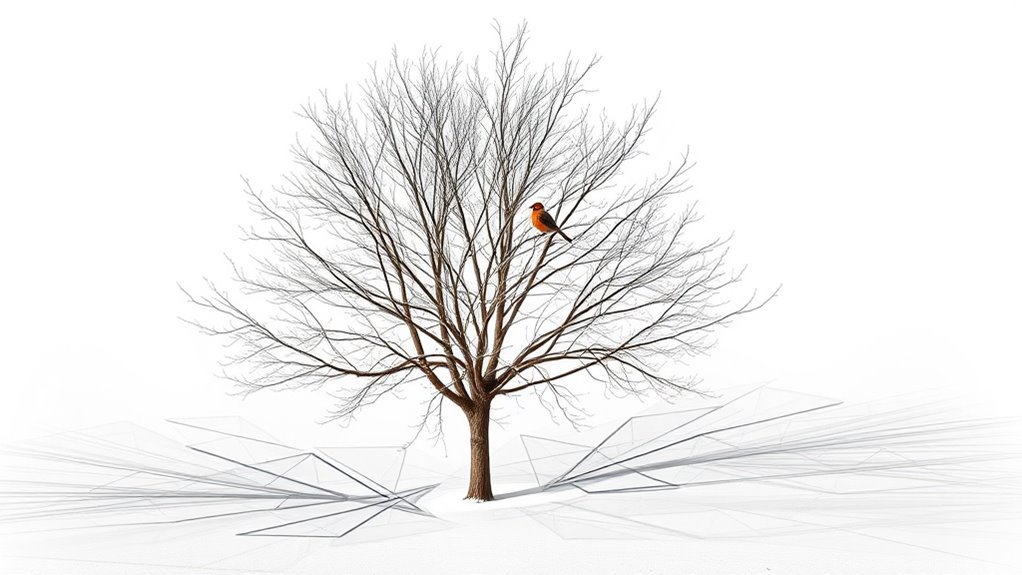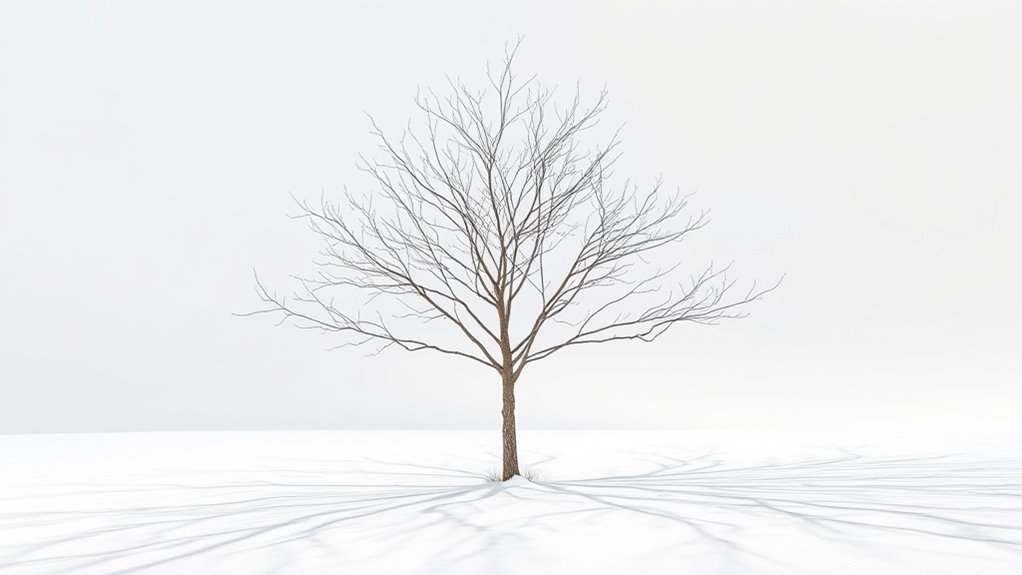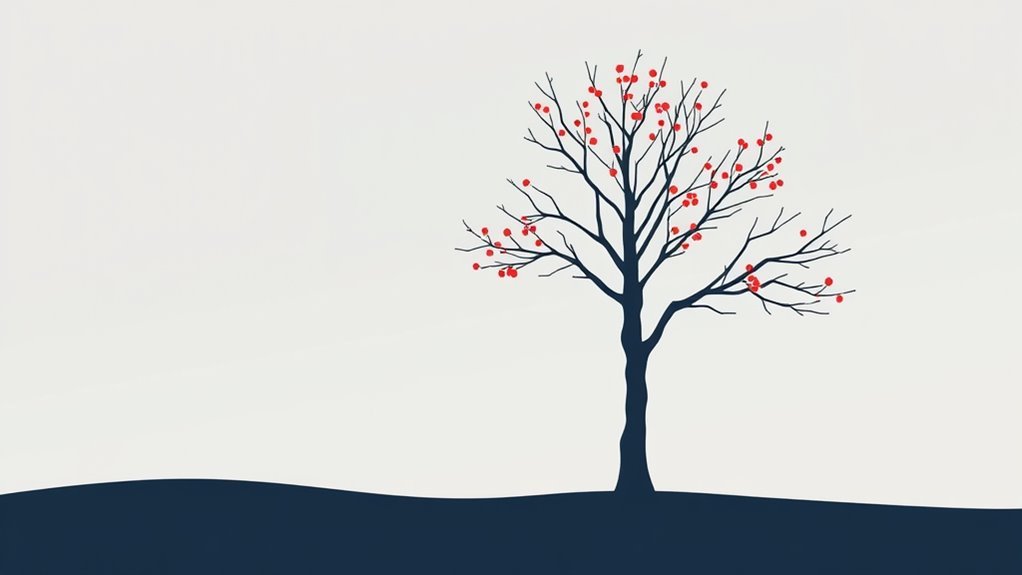The Eastern Redbud tree showcases a striking silhouette in winter, with gracefully arching branches and smooth gray bark. Its compact shape and fine branching structure stand out against the stark winter sky. As it enters dormancy, this hardy tree continues to support local wildlife, providing shelter and food. Winter gardens greatly benefit from the redbud's unique design and visual appeal. There are more aspects to discover about enhancing winter vistas with this elegant species.
Main Points
- The Eastern Redbud showcases a striking silhouette with gracefully arching branches and smooth, grayish bark during winter.
- Its compact and rounded shape, along with frost-laden branches, adds visual appeal to winter landscapes.
- The tree is resilient, thriving in USDA zones 4 to 9 and surviving frigid temperatures by entering dormancy.
- Eastern Redbuds provide ecological benefits, offering shelter and food for birds and overwintering insects in winter.
- Incorporate them into garden designs for unique structure and elegance, enhancing visual interest in winter landscapes.
Unique Structure of the Eastern Redbud in Winter
The Eastern Redbud tree presents a striking silhouette during winter, showcasing its unique structural features. Its distinctive heart-shaped leaves fall in autumn, leaving behind a network of gracefully arching branches. The smooth, often grayish bark reveals subtle patterns that contrast beautifully against the stark winter sky. The tree's shape remains compact and rounded, providing an elegant form that stands out in a winter scenery.
During this season, the redbud's fine branching structure becomes apparent, with slender twigs extending outward. This arrangement allows for ideal light capture, essential for its growth in the coming spring.
While other trees may appear lifeless, the Eastern Redbud retains a sense of character through its complex branching. Additionally, the presence of remaining seed pods adds a touch of visual interest, hinting at the vibrant blooms that will grace its branches when warmer weather returns.
The Beauty of Bare Branches

While winter strips many trees of their foliage, the bare branches of the Eastern Redbud offer a striking display of form and structure. Each branch twists and turns, creating a complex network that captures the eye. The smooth, gray bark contrasts beautifully with the delicate angles of the limbs, emphasizing the tree's unique silhouette against the winter sky.
When snow blankets the ground, the Eastern Redbud stands out even more, as its branches become laden with frost, sparkling like jewels in the sunlight. This stark beauty showcases the tree's graceful lines and provides a sense of tranquility amidst the cold.
Additionally, the bare branches reveal the tree's overall design, highlighting its rounded crown and the symmetry natural in its growth pattern.
In winter, the Eastern Redbud transforms, shifting from vibrant blooms to an elegant display of bare branches that invite admiration and contemplation.
Resilience and Hardiness in Cold Weather
Resilience characterizes the Eastern Redbud tree, enabling it to withstand the harsh conditions of winter. This deciduous tree exhibits extraordinary hardiness, thriving in USDA plant hardiness zones 4 to 9. It can tolerate frigid temperatures, often surviving dips below freezing without considerable damage.
The Eastern Redbud's unique physiological characteristics, such as its ability to enter dormancy, help it conserve energy and protect essential tissues during extreme cold. Additionally, its bark provides insulation, shielding the inner layers from frost and harsh winds.
This tree's extensive root system allows it to access moisture and nutrients even in frozen ground, ensuring survival until spring's warmth returns. While many plants struggle with winter's challenges, the Eastern Redbud stands resilient, showcasing its flexibility and strength.
Its enduring nature not only contributes to its survival but also highlights its value as a natural setting tree in colder climates, promoting stability and beauty year-round.
Wildlife Interactions During Winter

During winter, the Eastern Redbud tree plays an essential role in supporting local wildlife.
Bird activity patterns often shift as they seek shelter and food among its branches, while the tree also provides habitat opportunities for insects.
Observations of foraging behaviors reveal how various species adjust to the colder months, utilizing the resources offered by the tree.
Bird Activity Patterns
Although winter may seem a quiet time for the Eastern Redbud tree, it serves as an important resource for various bird species.
Throughout the colder months, birds such as cardinals, chickadees, and woodpeckers are often spotted foraging among the branches. The tree's bare limbs provide perches for these birds, allowing them to scout for food and identify potential predators.
Additionally, the Eastern Redbud's seeds and buds can attract species looking for sustenance during scarce winter months. The tree's structure also offers protection from harsh weather, making it a favored resting spot.
Consequently, the Eastern Redbud plays a crucial role in supporting avian life and maintaining ecological balance, even in the seemingly dormant winter scenery.
Insect Habitat Opportunities
Winter presents unique habitat opportunities for insects in and around the Eastern Redbud tree. Despite the cold, the tree's structure offers shelter for various insect species.
The tree's bark, with its crevices and rough texture, provides refuge for overwintering insects such as beetles and certain species of wasps. Additionally, the fallen leaves create a microhabitat on the ground, where larvae and pupae can remain protected from harsh weather.
The redbud's twigs may also harbor eggs laid by various insects, ensuring the continuation of their life cycles when spring arrives. These habitats contribute to the biodiversity of the ecosystem, allowing insects to survive the winter and emerge when conditions become favorable.
Foraging Behaviors Observed
The Eastern Redbud tree serves as an important resource for various wildlife species in winter, particularly for foraging birds and mammals.
During this season, small mammals such as squirrels are frequently observed foraging among the tree's branches, seeking seeds and buds.
Birds, including cardinals and chickadees, also utilize the tree, pecking at the remaining seed pods and searching for insects hidden in the bark.
The tree's structure provides essential cover, allowing these creatures to evade predators while they forage.
Additionally, the redbud's vibrant flowers in spring attract pollinators, but its winter presence continues to support the local ecosystem.
The Eastern Redbud's role as a foraging site illustrates its significance in sustaining wildlife through colder months.
The Role of Eastern Redbud in Landscaping

When considering the aesthetic and functional aspects of landscaping, the Eastern Redbud tree emerges as a versatile choice that enriches any outdoor space. This deciduous tree, known for its striking pink to purple blossoms in early spring, serves as a focal point in gardens and yards.
Its heart-shaped leaves provide a lush green canopy during the warmer months, offering shade and visual interest.
Eastern Redbuds are particularly effective when planted in clusters or as part of a mixed border, creating a vibrant display that attracts pollinators like bees and butterflies. Additionally, their relatively small size makes them suitable for urban environments or smaller residential properties where space is limited.
The tree's ability to adjust to various soil types and its resistance to drought further amplify its appeal.
Altogether, the Eastern Redbud contributes not only beauty but also ecological benefits, making it an excellent choice for diverse landscaping needs.
Seasonal Maintenance Tips
Although the Eastern Redbud tree is known for its vibrant spring blossoms, proper seasonal maintenance is vital for its health and longevity.
During winter, it is important to monitor the tree for signs of disease or pest infestations. Regularly inspecting the bark for cracks or lesions can help catch potential issues early.
Pruning is another important aspect of winter maintenance; removing any dead or damaged branches encourages better growth in the spring.
Additionally, applying a layer of mulch around the base can help retain moisture and regulate soil temperature during colder months.
Watering should be adjusted according to rainfall, as winter droughts can still affect root health.
Finally, protecting the tree from heavy snow or ice accumulation is essential, as excessive weight can lead to branch breakage.
Following these maintenance tips will guarantee the Eastern Redbud remains healthy and vibrant for years to come.
Inspiring Winter Garden Designs With Redbuds
Inspiring winter garden designs can beautifully incorporate Eastern Redbud trees, showcasing their unique structure and elegance even in the colder months. Their distinctive, heart-shaped leaves and striking branches create an eye-catching silhouette against a backdrop of snow or frost.
Gardeners can improve these features by strategically placing redbuds near pathways or focal points, allowing their graceful form to draw the eye. Complementing redbuds with evergreen shrubs or ornamental grasses adds texture and contrasts the vivid bark.
Incorporating winter-blooming plants like hellebores or witch hazel can provide color and interest, enriching the overall visual appeal. Additionally, decorative elements such as bird feeders or sculptures can create visual appeal while attracting wildlife.
Lighting is another essential aspect; strategically placed lights can illuminate the redbud's features, transforming the garden into a magical winter wonderland. This thoughtful design approach guarantees that Eastern Redbuds remain a fascinating centerpiece throughout the winter season.
Common Questions
How Does the Eastern Redbud Tolerate Extreme Cold Temperatures?
The question of how certain trees tolerate extreme cold temperatures involves examining physiological adjustments, such as antifreeze proteins, bud protection mechanisms, and cellular structures that minimize ice formation, allowing them to survive harsh winter conditions effectively.
What Soil Conditions Are Best for Eastern Redbud in Winter?
Ideal soil conditions for the eastern redbud include well-draining, loamy soil enriched with organic matter. These conditions guarantee healthy root development and resilience during harsh winter months, providing necessary nutrients and preventing waterlogging that could harm the tree.
Can Eastern Redbuds Survive in Shaded Areas During Winter?
Eastern Redbuds can tolerate some shade, but excessive shading may weaken their growth and flowering potential. Ideally, they thrive in areas with partial sunlight, ensuring adequate energy for survival during the winter months.
Do Eastern Redbuds Attract Specific Winter Birds or Wildlife?
The question of whether specific winter birds or wildlife are attracted to certain trees highlights the importance of biodiversity. Observations indicate that various species may seek shelter or food from trees, enhancing local ecosystems during colder months.
How Does Winter Affect Eastern Redbud's Growth Rate in Spring?
Winter conditions greatly influence a tree's growth rate in spring. Colder temperatures and dormancy periods can lead to delayed budding and reduced growth, eventually affecting the total health and vigor of the tree's spring emergence.

